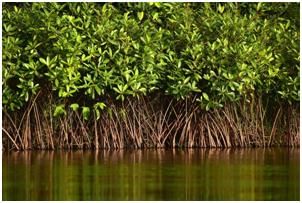Class 4 Exam > Class 4 Questions > Mangroves develop aerial roots. This is an ad...
Start Learning for Free
Mangroves develop aerial roots. This is an adaptation to the
- a)amount of water available
- b)temperature
- c)type of soil
- d)amount of rain
Correct answer is option 'A'. Can you explain this answer?
Most Upvoted Answer
Mangroves develop aerial roots. This is an adaptation to thea)amount o...
- Mangroves grow in marshy areas. Marshy soil have clay soil with plenty of water and has no air.
- The water cannot drain away and remains in the soil.
- Hence the plants in the soil develop breathing roots that help the roots to breathe.
Check out the image of Mangroves below:

Free Test
FREE
| Start Free Test |
Community Answer
Mangroves develop aerial roots. This is an adaptation to thea)amount o...
Understanding Aerial Roots in Mangroves
Mangroves are unique trees that thrive in coastal intertidal zones, where the land meets the sea. One of their remarkable adaptations is the development of aerial roots.
Why Do Mangroves Have Aerial Roots?
- Adaptation to Waterlogged Conditions:
Mangroves often grow in waterlogged, saline soils where oxygen levels are low. Aerial roots allow these plants to access atmospheric oxygen directly.
- Survival in Changing Water Levels:
Tidal fluctuations can submerge the roots in saltwater. Aerial roots help mangroves breathe when the water rises, ensuring they receive the oxygen necessary for survival.
- Stability in Soft Soils:
Mangroves typically grow in muddy, unstable soils. Aerial roots provide additional support, anchoring the trees firmly and preventing them from being washed away by strong tides and currents.
Benefits of Aerial Roots
- Enhanced Respiration:
Aerial roots are specialized for gas exchange, enabling efficient respiration even in anaerobic conditions.
- Adaptation to Salinity:
These roots can filter out salt from the water, allowing mangroves to thrive in salty environments.
- Support for Ecosystem:
Aerial roots create habitats for various marine life, contributing to biodiversity in coastal ecosystems.
In summary, the development of aerial roots in mangroves is primarily an adaptation to the availability of water and the unique challenges posed by their environment. This adaptation ensures their survival and plays a vital role in coastal ecosystems.
Mangroves are unique trees that thrive in coastal intertidal zones, where the land meets the sea. One of their remarkable adaptations is the development of aerial roots.
Why Do Mangroves Have Aerial Roots?
- Adaptation to Waterlogged Conditions:
Mangroves often grow in waterlogged, saline soils where oxygen levels are low. Aerial roots allow these plants to access atmospheric oxygen directly.
- Survival in Changing Water Levels:
Tidal fluctuations can submerge the roots in saltwater. Aerial roots help mangroves breathe when the water rises, ensuring they receive the oxygen necessary for survival.
- Stability in Soft Soils:
Mangroves typically grow in muddy, unstable soils. Aerial roots provide additional support, anchoring the trees firmly and preventing them from being washed away by strong tides and currents.
Benefits of Aerial Roots
- Enhanced Respiration:
Aerial roots are specialized for gas exchange, enabling efficient respiration even in anaerobic conditions.
- Adaptation to Salinity:
These roots can filter out salt from the water, allowing mangroves to thrive in salty environments.
- Support for Ecosystem:
Aerial roots create habitats for various marine life, contributing to biodiversity in coastal ecosystems.
In summary, the development of aerial roots in mangroves is primarily an adaptation to the availability of water and the unique challenges posed by their environment. This adaptation ensures their survival and plays a vital role in coastal ecosystems.

|
Explore Courses for Class 4 exam
|

|
Question Description
Mangroves develop aerial roots. This is an adaptation to thea)amount of water availableb)temperaturec)type of soild)amount of rainCorrect answer is option 'A'. Can you explain this answer? for Class 4 2025 is part of Class 4 preparation. The Question and answers have been prepared according to the Class 4 exam syllabus. Information about Mangroves develop aerial roots. This is an adaptation to thea)amount of water availableb)temperaturec)type of soild)amount of rainCorrect answer is option 'A'. Can you explain this answer? covers all topics & solutions for Class 4 2025 Exam. Find important definitions, questions, meanings, examples, exercises and tests below for Mangroves develop aerial roots. This is an adaptation to thea)amount of water availableb)temperaturec)type of soild)amount of rainCorrect answer is option 'A'. Can you explain this answer?.
Mangroves develop aerial roots. This is an adaptation to thea)amount of water availableb)temperaturec)type of soild)amount of rainCorrect answer is option 'A'. Can you explain this answer? for Class 4 2025 is part of Class 4 preparation. The Question and answers have been prepared according to the Class 4 exam syllabus. Information about Mangroves develop aerial roots. This is an adaptation to thea)amount of water availableb)temperaturec)type of soild)amount of rainCorrect answer is option 'A'. Can you explain this answer? covers all topics & solutions for Class 4 2025 Exam. Find important definitions, questions, meanings, examples, exercises and tests below for Mangroves develop aerial roots. This is an adaptation to thea)amount of water availableb)temperaturec)type of soild)amount of rainCorrect answer is option 'A'. Can you explain this answer?.
Solutions for Mangroves develop aerial roots. This is an adaptation to thea)amount of water availableb)temperaturec)type of soild)amount of rainCorrect answer is option 'A'. Can you explain this answer? in English & in Hindi are available as part of our courses for Class 4.
Download more important topics, notes, lectures and mock test series for Class 4 Exam by signing up for free.
Here you can find the meaning of Mangroves develop aerial roots. This is an adaptation to thea)amount of water availableb)temperaturec)type of soild)amount of rainCorrect answer is option 'A'. Can you explain this answer? defined & explained in the simplest way possible. Besides giving the explanation of
Mangroves develop aerial roots. This is an adaptation to thea)amount of water availableb)temperaturec)type of soild)amount of rainCorrect answer is option 'A'. Can you explain this answer?, a detailed solution for Mangroves develop aerial roots. This is an adaptation to thea)amount of water availableb)temperaturec)type of soild)amount of rainCorrect answer is option 'A'. Can you explain this answer? has been provided alongside types of Mangroves develop aerial roots. This is an adaptation to thea)amount of water availableb)temperaturec)type of soild)amount of rainCorrect answer is option 'A'. Can you explain this answer? theory, EduRev gives you an
ample number of questions to practice Mangroves develop aerial roots. This is an adaptation to thea)amount of water availableb)temperaturec)type of soild)amount of rainCorrect answer is option 'A'. Can you explain this answer? tests, examples and also practice Class 4 tests.

|
Explore Courses for Class 4 exam
|

|
Signup for Free!
Signup to see your scores go up within 7 days! Learn & Practice with 1000+ FREE Notes, Videos & Tests.


















